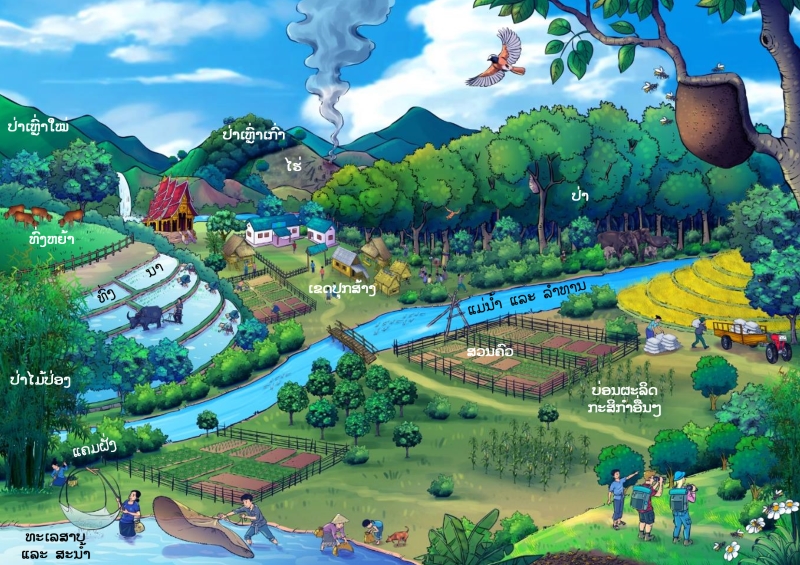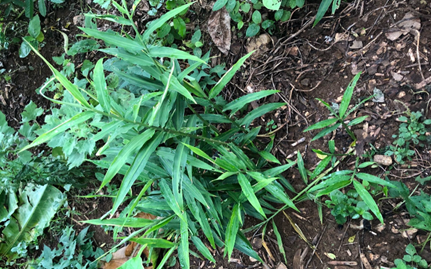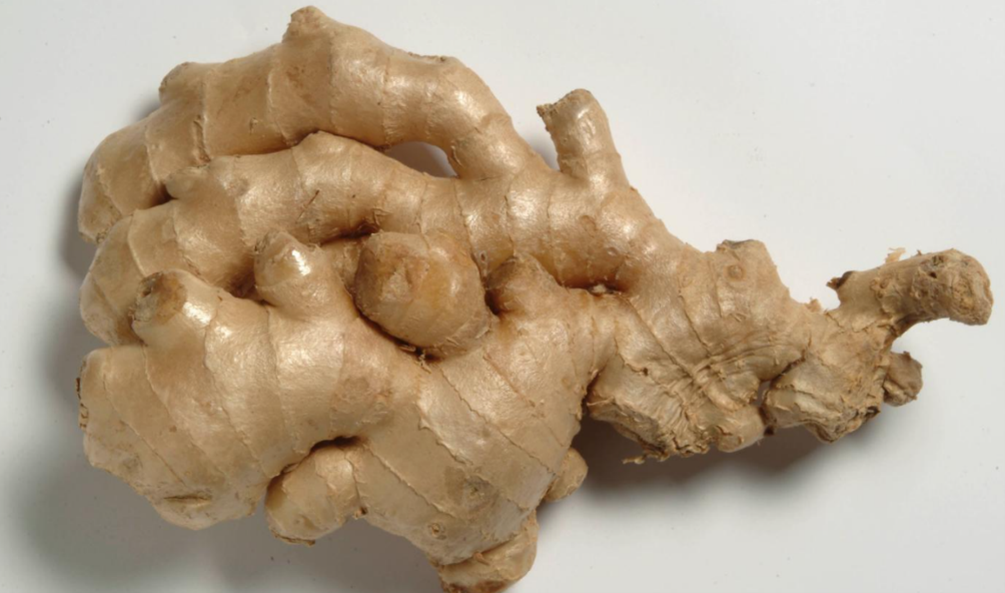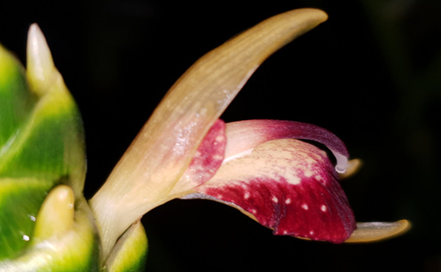ເລກລຳດັບທີ: 675
ລະດັບການຮວບຮວມຂໍ້ມູນ: ຂໍ້ມູນພື້ນຖານ
ປັບປູງຄັ້ງລ່າສຸດ: N/A
ຂີງ
Ginger
Zingiber officinale Roscoe
ພືດ
ພືດລົ້ມລຸກ
ຜັກ ແລະ ພືດລົ້ມລຸກ
×
ຊື່ທ້ອງຖີ່ນ:
ຮລັດເວລ (ກຶມມຸ) ( Garden Ginger)
ຊື່ພ້ອງ
:
Amomum angustifolium Salisb.
Amomum zingiber L.
Amomum zinziba Hill
Curcuma longifolia Wall.
Zingiber aromaticum Noronha
Zingiber cholmondeleyi (F.M.Bailey) K.Schum.
Zingiber majus Rumph.
Zingiber missionis Wall.
Zingiber missionis Wall. ex Baker
Zingiber officinale f. macrorhizonum (Makino) M.Hiroe
Zingiber officinale f. rubens (Makino) M.Hiroe
Zingiber officinale subsp. cholmondeleyi F.M.Bailey
Zingiber officinale subsp. macrorhizonum (Makino) M.Hiroe
Zingiber officinale subsp. rubens (Makino) M.Hiroe
Zingiber officinale subsp. rubrum Theilade
Zingiber officinale subsp. sichuanense (Z.Y.Zhu, S.L.Zhang & S.X.Chen) Z.Y.Zhu & S.L.Zhang
Zingiber officinale var. cholmondeleyi F.M.Bailey
Zingiber officinale var. macrorhizonum Makino
Zingiber officinale var. rubens Makino
Zingiber officinale var. rubrum Theilade
Zingiber sianginensis Tatum & A.K.Das
Amomum zingiber L.
Amomum zinziba Hill
Curcuma longifolia Wall.
Zingiber aromaticum Noronha
Zingiber cholmondeleyi (F.M.Bailey) K.Schum.
Zingiber majus Rumph.
Zingiber missionis Wall.
Zingiber missionis Wall. ex Baker
Zingiber officinale f. macrorhizonum (Makino) M.Hiroe
Zingiber officinale f. rubens (Makino) M.Hiroe
Zingiber officinale subsp. cholmondeleyi F.M.Bailey
Zingiber officinale subsp. macrorhizonum (Makino) M.Hiroe
Zingiber officinale subsp. rubens (Makino) M.Hiroe
Zingiber officinale subsp. rubrum Theilade
Zingiber officinale subsp. sichuanense (Z.Y.Zhu, S.L.Zhang & S.X.Chen) Z.Y.Zhu & S.L.Zhang
Zingiber officinale var. cholmondeleyi F.M.Bailey
Zingiber officinale var. macrorhizonum Makino
Zingiber officinale var. rubens Makino
Zingiber officinale var. rubrum Theilade
Zingiber sianginensis Tatum & A.K.Das
ຊື່ສະກຸນ:
Zingiberracea
ຊະນິດໃກ້ຄຽງ:
ຫວ້ານໄພ / Cassumunar ginger
ຂີງກະທຶ້ / Shampoo Ginger
ຂີງປ່າຂາວ / Whit Rounded Wing Ginger
ຂີງປ່າແດງ/ Wild Red Bract Ginger
ຂີງປ່າຂຽວ/ Phu Phane Ginger
ຂີງກະທຶ້ / Shampoo Ginger
ຂີງປ່າຂາວ / Whit Rounded Wing Ginger
ຂີງປ່າແດງ/ Wild Red Bract Ginger
ຂີງປ່າຂຽວ/ Phu Phane Ginger
ບັນຍາຍລັກສະນະທາງພືດສາດ:
ຂີງ (Zingiber officinale) ເປັນພືດສະໝູນໄພທີ່ມີໃບດ່ຽວມີຖິ່ນກຳເນີດຢູ່ໃນເຂດຮ້ອນຊຸ່ມ. ພືດສະໝູນໄພຢືນຕົ້ນຊະນິດນີ້ມີອາຍຸຫລາຍປີ ປົກກະຕິຈະເລີນເຕີບໂຕສູງເຖິງ 2 ຫາ 4 ຟຸດ ແລະ ມີໃບຄ້າຍຄືຫຍ້າທີ່ມີຄວາມຍາວເຖິງ 1 ຟຸດ. ມັນມີຮາກໃຕ້ດິນທີ່ແຂງ ແລະ ມັນໄດ້ຮັບການນໍາໃຊ້ຢ່າງກວ້າງຂວາງໃນການປຸງແຕ່ງອາຫານ ແລະ ການຢາ. ເຫງົ້າປະກອບມີໂຄງສ້າງແຂງນ້ອຍໆເປັນຈຳນວນລາຍ ເຊິ່ງມັກຈະງ່າອອກຄືກັບຕົ້ນປາມ. ຮູບຮ່າງຂອງເຫງົ້າແມ່ນຂຶ້ນກັບຂອງດິນທີ່ມັນຖືກປູກ. ເຫົ້ງາທີ່ຢູ່ໃນດິນແມ່ນມີຄຸນຄ່າເປັນພິເສດເນື່ອງຈາກມີລັກສະນະຊື່ ແລະ ບໍ່ເສ້ຍຮູບ, ເນື່ອງຈາກວ່າດິນສວນຊ່ວຍສະຫນອງໃນການຈະເລີນເຕີບໂຕ. ຮາກເຫງົ້າມີຂະໜາດນ້ອຍ ແລະ ຮາກຝອຍເປັນຈຳນວນຫຼາຍ ຊຶ່ງມັກຈະແຕກອອກຢູ່ເທິງໜ້າດິນ.
ຕົ້ນຂີງມີລໍາຕົ້ນຍາວ ອ່ອນໆສາມາດສູງໄດ້ເຖິງ 1 ແມັດ, ຖືກຫໍ່ຫຸ້ມຢ່າງແໜ້ນໜ້າໂດຍໃບ. ໂດຍປົກກະຕິຊໍ່ດອກແມ່ນບໍ່ມີໃບແຕ່ບາງເທື່ອມັນອາດຈະເບິ່ງຄືມີໃບ ໂດຍແຕກງອກອອກມາເປັນໜໍ່ຍາວ ປະມານ 30 ຊມ. [1]
ສ່ວນທີ່ຢູ່ໃຕ້ດິນ(ຫົວ/ເຫງົ້າ): ຂີງມີຫົວ(ເຫງົ້າຢູ່ໃຕ້ດິນ) ແຕກກິ່ງງ່າ ກ້ານໝາ ແລະ ມີລັກສະນະພິເສດ. ເຊິ່ງບາງຄັ້ງອາດຈະເບິ່ງຄືວ່າລຳຕົ້ນບວມຂື້ນ. ປອກຫຸ້ມເຫງົ້າມີສີນ້ຳຕານ (ປົກກະຕິຖ້າລອກອອກຈະເປັນກ່ອນໃຊ້) ແລະ ທາງກາງມີສີເຫຼືອງຈືດໆທີ່ສົ່ງກິ່ນຫອມຄາຍຄືໝາກນາວ.
ໃບ: ຕົ້ນຂີງສາມາດເຕີບໃຫຍ່ໄດ້ເຖິງ 1.2 ແມັດ ແລະ ງອກອອກມາຈາກຕາຢູ່ເຫງົ້າ. ຕົ້ນຂີງເຫຼົ່ານີ້ເກີດຈາກຖານໃບທີ່ຫຸ້ມຫໍ່ຢ່າງແໜ້ນໜາ (ກາບໃບ). ແຜ່ນໃບຍາວ, ແຄບສາມາດມີຄວາມຍາວເຖິງ 7 ຊມ ແລະ ກວ້າງເຖິງ 1.9 ຊມ, ຈັດລຽງສະລັບກັນໂດຍມີສີຂຽວປານກາງ.
ຊໍ່ດອກ: ຫົວດອກມີຮວງເປັນຮູບຈວຍ ມີກ້ານດອກສັ້ນກວ່າ ແລະ ປະກອບດ້ວຍຊໍ່ດອກສີຂຽວ, ສີອອກເຫຼືອງ, ກ້ານໃບຄ້າຍຄືໃບ ມີສີເຫຼືອງຈືດ, ມີປາກສີມ່ວງ, ປະດັບດ້ວຍລາຍສີເຫຼືອງເລີຍອອກທາງຂອບນອກຂອງປາຍຍອດ. ໂດຍສະເພາະ ກາບອອກດອກແມ່ນບໍ່ຄ່ອຍເຫັນໃນພືດທຸກຊະນິດທີ່ປູກ. [2]
ແຫຼ່ງທີ່ມາ: [1], [2]
ຕົ້ນຂີງມີລໍາຕົ້ນຍາວ ອ່ອນໆສາມາດສູງໄດ້ເຖິງ 1 ແມັດ, ຖືກຫໍ່ຫຸ້ມຢ່າງແໜ້ນໜ້າໂດຍໃບ. ໂດຍປົກກະຕິຊໍ່ດອກແມ່ນບໍ່ມີໃບແຕ່ບາງເທື່ອມັນອາດຈະເບິ່ງຄືມີໃບ ໂດຍແຕກງອກອອກມາເປັນໜໍ່ຍາວ ປະມານ 30 ຊມ. [1]
ສ່ວນທີ່ຢູ່ໃຕ້ດິນ(ຫົວ/ເຫງົ້າ): ຂີງມີຫົວ(ເຫງົ້າຢູ່ໃຕ້ດິນ) ແຕກກິ່ງງ່າ ກ້ານໝາ ແລະ ມີລັກສະນະພິເສດ. ເຊິ່ງບາງຄັ້ງອາດຈະເບິ່ງຄືວ່າລຳຕົ້ນບວມຂື້ນ. ປອກຫຸ້ມເຫງົ້າມີສີນ້ຳຕານ (ປົກກະຕິຖ້າລອກອອກຈະເປັນກ່ອນໃຊ້) ແລະ ທາງກາງມີສີເຫຼືອງຈືດໆທີ່ສົ່ງກິ່ນຫອມຄາຍຄືໝາກນາວ.
ໃບ: ຕົ້ນຂີງສາມາດເຕີບໃຫຍ່ໄດ້ເຖິງ 1.2 ແມັດ ແລະ ງອກອອກມາຈາກຕາຢູ່ເຫງົ້າ. ຕົ້ນຂີງເຫຼົ່ານີ້ເກີດຈາກຖານໃບທີ່ຫຸ້ມຫໍ່ຢ່າງແໜ້ນໜາ (ກາບໃບ). ແຜ່ນໃບຍາວ, ແຄບສາມາດມີຄວາມຍາວເຖິງ 7 ຊມ ແລະ ກວ້າງເຖິງ 1.9 ຊມ, ຈັດລຽງສະລັບກັນໂດຍມີສີຂຽວປານກາງ.
ຊໍ່ດອກ: ຫົວດອກມີຮວງເປັນຮູບຈວຍ ມີກ້ານດອກສັ້ນກວ່າ ແລະ ປະກອບດ້ວຍຊໍ່ດອກສີຂຽວ, ສີອອກເຫຼືອງ, ກ້ານໃບຄ້າຍຄືໃບ ມີສີເຫຼືອງຈືດ, ມີປາກສີມ່ວງ, ປະດັບດ້ວຍລາຍສີເຫຼືອງເລີຍອອກທາງຂອບນອກຂອງປາຍຍອດ. ໂດຍສະເພາະ ກາບອອກດອກແມ່ນບໍ່ຄ່ອຍເຫັນໃນພືດທຸກຊະນິດທີ່ປູກ. [2]
ແຫຼ່ງທີ່ມາ: [1], [2]
ນິເວດວິທະຍາ
ເຂດກະຈາຍພັນທົ່ວໂລກ:
Global distribution. Source: [3]
ເຂດກະຈາຍພັນໃນລາວ
:
ທົ່ງພຽງວຽງຈັນ

ເຂດກະຈາຍພັນຕາມພູມສັນຖານ
:
ເຂດຜະລິດພືດຜົນເນີນສູງ
ທົ່ງນາ
ທົ່ງນາ

ສະເພາະຖິ່ນໃນລາວ:
ຕ່າງຖິ່ນ
ຮຸກຮານ
:
ບໍ່ຮຸກຮານ
ສະຖານະພາບການອະນູຮັກ IUCN
:
ມີຄວາມສ່ຽງໜ້ອຍສຸດ
ສະຖານະພາບການອະນຸຮັກແຫ່ງຊາດລາວ
:
ບໍ່ຖືກລະບຸໃນບັນຊີປະເພດໃດ
ການນຳໃຊ້
ປະເພດການນຳໃຊ້:
ການຄົມມະນາຄົມ
ກິດຈະກຳການກະເສດ
ອາຫານ
ພືດເປັນຢາ
ກິດຈະກຳການກະເສດ
ອາຫານ
ພືດເປັນຢາ
ບັນຍາຍການນຳໃຊ້:
ອາຫານ: ຂີງ, ມີລົດຊາດເຜັດເລັກນ້ອຍ, ຖືກນໍາໃຊ້ທົ່ວໄປໃນຮູບແບບແຫ້ງ ແລະ ດິບ ເພື່ອເພີ່ມລົດຊາດຂອງເຂົ້າຈີ່, ຊອດ, ຖ້ວຍແກງເກີລີ, ເຂົ້າໜົມ, ອາຫານດອງ, ແລະ ເບຍຂີງ. ຫົຂີງທີ່ເອີ້ນວ່າຂີງຂຽວ ຍັງເປັນທີ່ນິຍົມໃນການປຸງແຕ່ງອາຫານເຊັ່ນ: ຫົວຂີງແຫ້ງປອກເປືອກແລ້ວຕົ້ມໃສ່ຢານ້ຳເຊືອມເພື່ອຖະນອມອາຫານ. ໃນປະເທດຍີ່ປຸ່ນ ແລະ ວັດທະນະທໍາອື່ນໆ ມັກຈະເສີບຂີງທີ່ຫັ່ນເປັນຕ່ອນນ້ອຍໆເພື່ອເຮັດຄວາມສະອາດປາກລະຫວ່າງກິນເຂົ້າແລ້ວ.ນອກຈາກການນໍາໃຊ້ເຮັດອາຫານແລ້ວ ຂີງໄດ້ຍັງຖືກຍອມຮັບວ່າມີຄຸນສົມບັດດ້ານການຢາ ແລະ ມັກນໍາໃຊ້ເພື່ອບັນເທົາອາການທ້ອງອືດ ແລະ ທ້ອງຜູກ. [4]
ການຄ້າ: ຂີງຖືກນໍາໃຊ້ອຸດສາຫະກໍາຢາ, ເສດຖະກິດ ແລະ ອາຫານຢ່າງປອດໄພ. ຫົວໃນດິນ(ເຫງົ້າ) ແມ່ນຜະລິດຕະພັນທາງການຄ້າທີ່ມີຄວາມຕ້ອງການສູງ. ມີກິ່ນຫອມທີ່ກະຕຸ້ນ ແລະ ລົດຊາດທີ່ມີຄວາມເປັນເອກະລັກຂອງຂີງທີ່ເຮັດໃຫ້ມັນເປັນສ່ວນປະກອບສໍາຄັນຂອງອາຫານທົ່ວໂລກ ແລະ ອຸດສາຫະກໍາການແປຮູບອາຫານ.[1]
ການຢາ: ຂີງຖືວ່າມ່ຖວາມສຳຄັນດ້ານການຢາ ຢູ່ໃນຢາພື້ນເມືອງຂອງຈີນ, ອິນເດຍ ແລະ ຍີ່ປຸ່ນເປັນເວລາຫຼາຍກວ່າ 25 ສະຕະວັດ. ຂີງຍັງມີປະໂຫຍດທາງການແພດຢ່າງຫຼວງຫຼາຍ ແລະ ມີຄວາມສໍາຄັນໃນການຍ່ອຍອາຫານ ເປັນຢາຂັບລົມ, ຫຼຸດແກ໊ດໃນກະເພາະ ແລະ ທ້ອງອືດ. ຂີງຍັງມີນ້າທີໃນການຕ້ານອາການເຈັບປວດຂໍ້ ແລະ ໂລກຂໍ້ອັກເສບແຕ່ລວມທັງການອັກເສບທີ່ເກີດຈາກລັງສີ ມີລາຍງານວ່າມີຂີງມີປະສິດຕິພາບໃນການຕ້ານເນື້ອງອກ ແລະ ອາການປວດຮາກໃນຂະນະທີ່ຕັງທີ່ຕັງຄັນ. ນັກວິໄຈຫຼາຍທ່ານຍ້ອມຮັບວ່າຂີງເປັນພືດທີ່ມີສານຕ້ານອະນຸມູນອິດສະລະ ໃນປະລິມານສູງ . ຜົງຂອງຂີງມີປະສິດທິພາບຮັກສາອາການແຊກຊອນ ຫຼັງງການຜ່າຕັດ. [1]
ການຄ້າ: ຂີງຖືກນໍາໃຊ້ອຸດສາຫະກໍາຢາ, ເສດຖະກິດ ແລະ ອາຫານຢ່າງປອດໄພ. ຫົວໃນດິນ(ເຫງົ້າ) ແມ່ນຜະລິດຕະພັນທາງການຄ້າທີ່ມີຄວາມຕ້ອງການສູງ. ມີກິ່ນຫອມທີ່ກະຕຸ້ນ ແລະ ລົດຊາດທີ່ມີຄວາມເປັນເອກະລັກຂອງຂີງທີ່ເຮັດໃຫ້ມັນເປັນສ່ວນປະກອບສໍາຄັນຂອງອາຫານທົ່ວໂລກ ແລະ ອຸດສາຫະກໍາການແປຮູບອາຫານ.[1]
ການຢາ: ຂີງຖືວ່າມ່ຖວາມສຳຄັນດ້ານການຢາ ຢູ່ໃນຢາພື້ນເມືອງຂອງຈີນ, ອິນເດຍ ແລະ ຍີ່ປຸ່ນເປັນເວລາຫຼາຍກວ່າ 25 ສະຕະວັດ. ຂີງຍັງມີປະໂຫຍດທາງການແພດຢ່າງຫຼວງຫຼາຍ ແລະ ມີຄວາມສໍາຄັນໃນການຍ່ອຍອາຫານ ເປັນຢາຂັບລົມ, ຫຼຸດແກ໊ດໃນກະເພາະ ແລະ ທ້ອງອືດ. ຂີງຍັງມີນ້າທີໃນການຕ້ານອາການເຈັບປວດຂໍ້ ແລະ ໂລກຂໍ້ອັກເສບແຕ່ລວມທັງການອັກເສບທີ່ເກີດຈາກລັງສີ ມີລາຍງານວ່າມີຂີງມີປະສິດຕິພາບໃນການຕ້ານເນື້ອງອກ ແລະ ອາການປວດຮາກໃນຂະນະທີ່ຕັງທີ່ຕັງຄັນ. ນັກວິໄຈຫຼາຍທ່ານຍ້ອມຮັບວ່າຂີງເປັນພືດທີ່ມີສານຕ້ານອະນຸມູນອິດສະລະ ໃນປະລິມານສູງ . ຜົງຂອງຂີງມີປະສິດທິພາບຮັກສາອາການແຊກຊອນ ຫຼັງງການຜ່າຕັດ. [1]
ການປູກ ການລ້ຽງ:
ປູກ ແລະ ທຳມະຊາດ
ລະດູການເກັບກູ້:
ມິຖຸນາ
ກໍລະກົດ
ສິງຫາ
ກັນຍາ
ກໍລະກົດ
ສິງຫາ
ກັນຍາ
ການຕະຫຼາດ ແລະ ຕ່ອງໂສ້ມູນຄ່າ:
N/A
ການຄຸ້ມຄອງຈັດການ
ເທັກນິກການປູກ:
ຊີວະວິທະຍາຂອງດອກ ແລະ ການປະສົມເກສອນ: ກາບດອກຂອງດອກຂີງມີສີຂາວ ແລະ ແຕ່ລະດອກມີເພດຮ່ວມຖືກຫຸ້ມດ້ວຍກ້ານໃບ ເຊິ່ງເປັນໂຄງສ້າງຄ້າຍຄືໃບ ບາງດອກຍັງຜະລິດດອກມີເພດດຽວ. ດອກຂີງມີກາບດອກລຽງສາມໃບ ມີກາບໜຶ່ງໃຫຍ່ກວ່າກາບອື່ນ ແລະ ມີລັກສະນະໂປ່ງໃສພ້ອມກັບສີເຫຼືອງອ່ອນ. ເມື່ອດອກໄມ້ເລີ່ມບານ ມັນສີແດງອ່ນ, ເຊິ່ງໃເປັນສີທີ່ຖືກປ້ອງກັນໂດຍກາບດອກ ມັນມີສີເຫຼືອງຈືດຢູ່ດ້ານນອກ ແລະ ສີແດງເຂັ້ມຢູ່ພາຍໃນ, ແລະ ມັກຈະມີຈຸດສີເຫຼືອງປົນຢູ່. [1]
ວິທີການປັບປຸງພັນ: ໃນພືດທີ່ຂະຫຍາຍພັນແບບໂຄນເຊັ່ນ: ຂີງ ອົງປະກອບທີ່ສໍາຄັນສອງຢ່າງຂອງຊີວະນາໆພັນແມ່ນຄວາມຫຼາກຫຼາຍຂອງຊະນິດພັນ ແລະຄວາມຫຼາກຫຼາຍຊະນິດ ເຊິ່ງຊ່ວຍໃຫ້ມີຄວາມກົດດັນໃນການຄັດເລືອກທີ່າົ່ງຜົນກະທົບຕໍ່ປະຊາກອນ. ວິວັດທະນາການຂອງຂີງໄດ້ມີການປ່ຽນແປງທີ່ສຳຄັນໃນໂຄງສ້າງທາງຊີວະວິທະຍາ ແລະທາງກາຍຍະພາກ ເນື່ອງຈາກຂີງມີປະຫວັດສາດອັນຍາວນານໃນການຜະລິດພາຍໃນພື້ນທີພູມມີສາດທີ່ຫຼາກຫຼາຍ. [1]
ການເກັບກ່ຽວ:
ການປະຕິບັດຫຼັງການເກັບກ່ຽວ ແລະ ການປຸງແຕ່ງຂີງ: ການລ້າງ, "ຂ້າ," ແລະ ຕາກໃຫ້ແຫ້ງ:
ຫົວຂີງສົດຄວນລ້າງໃຫ້ສະອາດເພື່ອເອົາສິ່ງເສດເຫຼືອ, ໜໍ່ ແລະ ຮາກອອກ. ຖ້າເປັນໄປໄດ້ ຄວນລ້າງດ້ວຍນ້ຳທີ່ມີຄວາມກົດດັນ ຍ້ອນວ່າມັນມີປະສິດທິພາບຫຼາຍ ແລະ ຊ່ວຍຫຼຸດປະລິມານຂອງຈຸລິນຊີ. ຫົວສາມາດ "ຂ້າ" ໄດ້ໂດຍການແຊ່ນ້ຳຕົ້ມໃນເວລາ 10 ນາທີ ເຊິ່ງຍັງສາມາດຍຸດການເຮັດວຽກຂອງເອັນໄຊອີກດ້ວຍ. ຫຼັງຈາກນີ້ ຄວນຕາກຫົວຂີງໃຫ້ແຫ້ງ. ອີກວິທີໜຶ່ງ ຄືມີການຂູດ, ປອກເປືອກ, ຫຼື ຫັ່ນຫົວເຫືອກອອກກ່ອນຕາກແຫ້ງ. ການປອກເປືອກຫຼືຂູດເພື່ອປຄຸນນະພາບຂອງຜະລິດຂັ້ນສຸດທ້າຍ. [5]
ການຫໍ່ ແລະ ການບັນຈຸພັນ: ຖ້າຫົວມີຈຳນວນຫຼາຍອາດຈະບັນຈຸຢູ່ໃນເປົ໋າ, ກ່ອງໄມ້, ຫຼື ກ່ອງເຈ້ຍທີ່ແແຂງເພື່ອຂົນສົ່ງ. ສຳລັບຫົວທີ່ແຫ້ງ ຫຼື ຜົງຄວນຈະບັນຈຸຢູ່ໃນຖົງຜ້າຫຼາຍຊັ້ນ. ແຜນ ລາມີນີຕາ ອາດມີປະສິດທິພາບຫຼາຍກ່ວາຊະນິດອື່ນໆເນື່ອງຈາກ ອາກາດ ສາມາດຊຶມຜ່ານໄດ້.ການເກັບຮັກສາໃນສະພາບແວດລ້ອມທີ່ເຢັນແລະແຫ້ງແມ່ນເໝາະສໍາຄັນສໍາລັບເຄື່ອງເທດແຫ້ງ. [5]
ຊີວະວິທະຍາຂອງດອກ ແລະ ການປະສົມເກສອນ: ກາບດອກຂອງດອກຂີງມີສີຂາວ ແລະ ແຕ່ລະດອກມີເພດຮ່ວມຖືກຫຸ້ມດ້ວຍກ້ານໃບ ເຊິ່ງເປັນໂຄງສ້າງຄ້າຍຄືໃບ ບາງດອກຍັງຜະລິດດອກມີເພດດຽວ. ດອກຂີງມີກາບດອກລຽງສາມໃບ ມີກາບໜຶ່ງໃຫຍ່ກວ່າກາບອື່ນ ແລະ ມີລັກສະນະໂປ່ງໃສພ້ອມກັບສີເຫຼືອງອ່ອນ. ເມື່ອດອກໄມ້ເລີ່ມບານ ມັນສີແດງອ່ນ, ເຊິ່ງໃເປັນສີທີ່ຖືກປ້ອງກັນໂດຍກາບດອກ ມັນມີສີເຫຼືອງຈືດຢູ່ດ້ານນອກ ແລະ ສີແດງເຂັ້ມຢູ່ພາຍໃນ, ແລະ ມັກຈະມີຈຸດສີເຫຼືອງປົນຢູ່. [1]
ວິທີການປັບປຸງພັນ: ໃນພືດທີ່ຂະຫຍາຍພັນແບບໂຄນເຊັ່ນ: ຂີງ ອົງປະກອບທີ່ສໍາຄັນສອງຢ່າງຂອງຊີວະນາໆພັນແມ່ນຄວາມຫຼາກຫຼາຍຂອງຊະນິດພັນ ແລະຄວາມຫຼາກຫຼາຍຊະນິດ ເຊິ່ງຊ່ວຍໃຫ້ມີຄວາມກົດດັນໃນການຄັດເລືອກທີ່າົ່ງຜົນກະທົບຕໍ່ປະຊາກອນ. ວິວັດທະນາການຂອງຂີງໄດ້ມີການປ່ຽນແປງທີ່ສຳຄັນໃນໂຄງສ້າງທາງຊີວະວິທະຍາ ແລະທາງກາຍຍະພາກ ເນື່ອງຈາກຂີງມີປະຫວັດສາດອັນຍາວນານໃນການຜະລິດພາຍໃນພື້ນທີພູມມີສາດທີ່ຫຼາກຫຼາຍ. [1]
ການເກັບກ່ຽວ:
ການປະຕິບັດຫຼັງການເກັບກ່ຽວ ແລະ ການປຸງແຕ່ງຂີງ: ການລ້າງ, "ຂ້າ," ແລະ ຕາກໃຫ້ແຫ້ງ:
ຫົວຂີງສົດຄວນລ້າງໃຫ້ສະອາດເພື່ອເອົາສິ່ງເສດເຫຼືອ, ໜໍ່ ແລະ ຮາກອອກ. ຖ້າເປັນໄປໄດ້ ຄວນລ້າງດ້ວຍນ້ຳທີ່ມີຄວາມກົດດັນ ຍ້ອນວ່າມັນມີປະສິດທິພາບຫຼາຍ ແລະ ຊ່ວຍຫຼຸດປະລິມານຂອງຈຸລິນຊີ. ຫົວສາມາດ "ຂ້າ" ໄດ້ໂດຍການແຊ່ນ້ຳຕົ້ມໃນເວລາ 10 ນາທີ ເຊິ່ງຍັງສາມາດຍຸດການເຮັດວຽກຂອງເອັນໄຊອີກດ້ວຍ. ຫຼັງຈາກນີ້ ຄວນຕາກຫົວຂີງໃຫ້ແຫ້ງ. ອີກວິທີໜຶ່ງ ຄືມີການຂູດ, ປອກເປືອກ, ຫຼື ຫັ່ນຫົວເຫືອກອອກກ່ອນຕາກແຫ້ງ. ການປອກເປືອກຫຼືຂູດເພື່ອປຄຸນນະພາບຂອງຜະລິດຂັ້ນສຸດທ້າຍ. [5]
ການຫໍ່ ແລະ ການບັນຈຸພັນ: ຖ້າຫົວມີຈຳນວນຫຼາຍອາດຈະບັນຈຸຢູ່ໃນເປົ໋າ, ກ່ອງໄມ້, ຫຼື ກ່ອງເຈ້ຍທີ່ແແຂງເພື່ອຂົນສົ່ງ. ສຳລັບຫົວທີ່ແຫ້ງ ຫຼື ຜົງຄວນຈະບັນຈຸຢູ່ໃນຖົງຜ້າຫຼາຍຊັ້ນ. ແຜນ ລາມີນີຕາ ອາດມີປະສິດທິພາບຫຼາຍກ່ວາຊະນິດອື່ນໆເນື່ອງຈາກ ອາກາດ ສາມາດຊຶມຜ່ານໄດ້.ການເກັບຮັກສາໃນສະພາບແວດລ້ອມທີ່ເຢັນແລະແຫ້ງແມ່ນເໝາະສໍາຄັນສໍາລັບເຄື່ອງເທດແຫ້ງ. [5]
ໂພຊະນາການ
ຄຸນຄ່າທາງໂພຊະນາການ:
ບັນຍາຍຄຸນຄ່າທາງໂພຊະນາການ:
N/A
| ສານອາຫານ | /100g | ໝາຍເຫດ |
|---|---|---|
| ໂປຣຕີນ | 1.82 | N/A |
| ຄາໂບໄຮເດຣດ | 7.8 | N/A |
| ໄຂມັນ | N/A | N/A |
| ວິຕາມິນ | N/A | Vitamin C 5 mg, Vitamin B6 0.16 mg |
| ແຮ່ທາດ | N/A | Zinc 0.34 mg |
| ເສັ້ນໄຍ | 2 | N/A |
ອ້າງອິງ
ເຄດິດຮູບພາບ:
Leaves. [1] iNaturalist [Online]. Uploaded on 10 August 2023 by C. R. Whitney. Available: https://www.gbif.org/occurrence/4925816034. [Accessed: 16 October 2024]
Rhizome. [2] iNaturalist [online]. Uploaded on 09 April 2020 by David Tng. Available: https://www.inaturalist.org/photos/79560909. [Accessed: 16 October 2024]
Flower. [3] Plants of the World Online [Online]. Uploaded by Royal Botanic Gar-dens Kew. Available: https://powo.science.kew.org/taxon/urn:lsid:ipni.org:names:798372-1/general-information. [Accessed: 16 October 2024]
Rhizome. [2] iNaturalist [online]. Uploaded on 09 April 2020 by David Tng. Available: https://www.inaturalist.org/photos/79560909. [Accessed: 16 October 2024]
Flower. [3] Plants of the World Online [Online]. Uploaded by Royal Botanic Gar-dens Kew. Available: https://powo.science.kew.org/taxon/urn:lsid:ipni.org:names:798372-1/general-information. [Accessed: 16 October 2024]
ອ້າງອິງ:
[1] iNaturalist [Online]. Uploaded on 10 August 2023 by C. R. Whitney. Available: https://www.gbif.org/occurrence/4925816034. [Accessed: 16 October 2024]
[2] iNaturalist [online]. Uploaded on 09 April 2020 by David Tng. Availa-ble: https://www.inaturalist.org/photos/79560909. [Accessed: 16 Oc-tober 2024]
[3] Plants of the World Online [Online]. Uploaded by Royal Botanic Gar-dens Kew. Available: https://powo.science.kew.org/taxon/urn:lsid:ipni.org:names:798372-1/general-information. [Accessed: 16 October 2024]
[1] A. M. Yadav, "Zingiber officinale (Roscoe) Ginger," ResearchGate, 2020. [Online]. Available: https://www.researchgate.net/publication/346151665_Zingiber_officinale_Roscoe_Ginger. [Accessed: 17 October 2024].
[2] Plants of the World Online, “Zingiber officinale Roscoe,” [Online]. Available: https://powo.science.kew.org/taxon/urn:lsid:ipni.org:names:798372-1/general-information. [Accessed: 17 October 2024]
[3] Global Biodiversity Information Facility (GBIF), “Zingiber officinale Roscoe,” Available: https://www.gbif.org/species/2757280. [Accessed: 22 October 2024]
[4] Britannica, “Zingiber officinale Roscoe,” [Online]. Available: https://www.britannica.com/plant/ginger. [Accessed: 17 October 2024]
[5] O. O Onu, K. J. SIMONYAN, and M.C Ndukwu, “A Review of Post Har-vest and Processing Technologies of Ginger (Zingiber Officinale) In Nige-ria,” Volume: 35, September 2014. [Onlin]. Available: https://shorturl.at/h6H4t.
[6] Sciencedirect, “Zingiber officinale Roscoe,” [Online]. Available: https://www.sciencedirect.com/science/article/abs/pii/B9780128124918000345. [Accessed: 17 October 2024]
[2] iNaturalist [online]. Uploaded on 09 April 2020 by David Tng. Availa-ble: https://www.inaturalist.org/photos/79560909. [Accessed: 16 Oc-tober 2024]
[3] Plants of the World Online [Online]. Uploaded by Royal Botanic Gar-dens Kew. Available: https://powo.science.kew.org/taxon/urn:lsid:ipni.org:names:798372-1/general-information. [Accessed: 16 October 2024]
[1] A. M. Yadav, "Zingiber officinale (Roscoe) Ginger," ResearchGate, 2020. [Online]. Available: https://www.researchgate.net/publication/346151665_Zingiber_officinale_Roscoe_Ginger. [Accessed: 17 October 2024].
[2] Plants of the World Online, “Zingiber officinale Roscoe,” [Online]. Available: https://powo.science.kew.org/taxon/urn:lsid:ipni.org:names:798372-1/general-information. [Accessed: 17 October 2024]
[3] Global Biodiversity Information Facility (GBIF), “Zingiber officinale Roscoe,” Available: https://www.gbif.org/species/2757280. [Accessed: 22 October 2024]
[4] Britannica, “Zingiber officinale Roscoe,” [Online]. Available: https://www.britannica.com/plant/ginger. [Accessed: 17 October 2024]
[5] O. O Onu, K. J. SIMONYAN, and M.C Ndukwu, “A Review of Post Har-vest and Processing Technologies of Ginger (Zingiber Officinale) In Nige-ria,” Volume: 35, September 2014. [Onlin]. Available: https://shorturl.at/h6H4t.
[6] Sciencedirect, “Zingiber officinale Roscoe,” [Online]. Available: https://www.sciencedirect.com/science/article/abs/pii/B9780128124918000345. [Accessed: 17 October 2024]
ຜູ້ສ້າງ Factsheet:
ຜູ້ກວດສອບ Factsheet:
,


